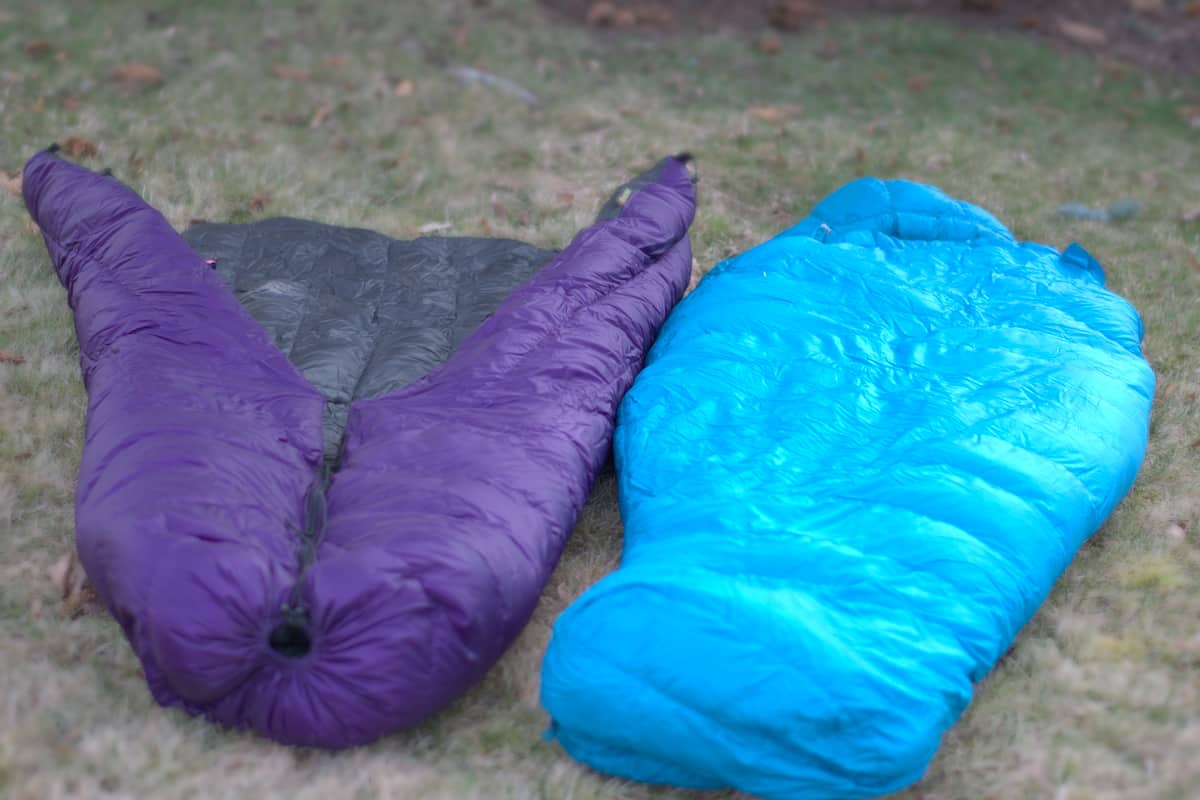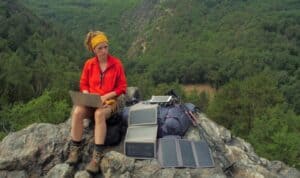Sleeping Bag vs Quilt: What’s the Best Option for You?

When it comes to sleeping bags or quilts, there are a lot of factors to consider. Which one is warmer? Which one is lighter? Does it have zippers? How warm does it keep you? These are all important questions to ask when deciding which sleeping system is best for you. We know you want to make an educated decision when you are purchasing your outdoor gear. In this article, we will discuss the pros and cons of sleeping bags vs quilts, and help you decide which option is right for you!
What’s the difference between a quilt and a sleeping bag?
A sleeping bag is typically a mummy shape that zips up and has a hood to keep your head warm. A quilt is typically a mummy-style also with a similar foot box style for your feet but with no zipper and can be used with or without a sleeping pad.
Ultralight gear is becoming more popular, and as such, the weight of your sleeping system is an important consideration. Sleeping bags can range from very heavy (over four pounds) to ultralight (under one pound). Quilts, on the other hand, are always ultralight, as they have no zipper or hood.
Is there a big cost difference between quilts and sleeping bags?
Many sleeping bags can be very expensive, especially if you are looking for an ultralight sleeping bag. Quilts, on the other hand, are much cheaper, as they use fewer materials and are simpler in design and construction. Quilts are most often cheaper than sleeping bags.
Sleeping bags are more complex to construct. They often have full-length zippers and neck collars for trapping warm air inside. Ultralight sleeping bags have to use more advanced materials to try to get the warmth to weight ratio higher.
A camping quilt is simpler than most sleeping bags. It uses less material to get the same weight savings. This makes it easier to produce quilts. Quilts are almost always cheaper than sleeping bags.
Another option is to build your own quilt
With their simple construction, many people sew their own camping quilts. This can be a fun project and you’ll end up with a unique camping quilt. You can end up with a custom quilt to get started in quilt camping.
If cost is a big consideration for you the difference between a sleeping bag and a quilt can really sway your decision. You will get a higher quality with the same temperature rating but lighter weight than the average sleeping bag with less cost.
Can quilts be as comfortable as a sleeping bag?
Quilts are becoming more popular for their comfort. Sleeping bags can be constrictive, especially if you are a side sleeper. Quilts provide the same warmth as sleeping bags but with more freedom of movement.
A quilt uses less material than a sleeping bag, so there is less space for your body heat to escape. Quilts are also more versatile than sleeping bags, as you can adjust them to fit the temperature. For example, on a cold night, you can close the quilt around you to trap your body heat, or on warmer nights, you can open the quilt up to ventilate.
Camping quilts have bigger foot boxes than sleeping bags tend to. The size of the foot box can make a big difference in how comfortable you are.
With most quilts, there is a way that the quilt attaches to your sleeping pad. Usually with some elastic straps. These ensure the quilt stays in place no matter how you move in the night.
How can a quilt be as warm as a sleeping bag?
With fewer features than a traditional sleeping bag, you would think that there is no way a quilt can keep you as warm as a mummy bag.
Let’s look at the factors that affect sleeping bag warmth.
The three factors that affect sleeping bag warmth are fill power, loft, and shell material.
Fill power is the measure of how much space one ounce of down takes up in the sleeping bag. The higher the fill power, the more insulating ability that sleeping bag has for its weight. Loft is how thick or thin the sleeping bag is. The thicker the sleeping bag, the more warmth it will have. Shell material is what protects you from the elements and can also add or subtract warmth to a sleeping bag.
Insulation type plays a big role in the warmth rating.
Down is the lightest, most compressible, and most expensive insulation on the market. It is made from the soft under feathers of ducks or geese. Down insulation has a great warmth-to-weight ratio and will keep you warm even when wet. Synthetic insulation is made from polyester fibers and is less expensive than down. It is also not as compressible as down, but it does insulate when wet.
What is the difference between down and synthetic quilts and sleeping bags?
The main difference between down and synthetic insulation backpacking quilts is that down is more compressible, lighter, and warmer than synthetic.
Down is made from the feathers of ducks or geese. The feathers are cleaned and then lofted to create light, warm insulation. Down is an excellent insulator because it traps a lot of air in its small feathers.
Synthetic backpacking quilts and synthetic bags are made from polyester fiber that is cut into short strands and then lofted to create light, warm insulation. Synthetic backpacking quilts are not as compressible as down, but they are cheaper and they perform better when wet.
Sleeping bags are typically warmer than quilts, but there are a few things you can do to make your quilt just as warm.
First, make sure your quilt has a good loft. The loft is the thickness of the sleeping bag and is measured in inches. A quilt with a higher loft will be warmer than a quilt with a lower loft.
Second, make sure your quilt has a good shell material. The shell material protects you from the elements and can also add or subtract warmth to a sleeping bag. A quilt with a good shell material will be warmer than a quilt with a poor shell material.
Third, make sure your quilt has good fill power. The fill power is the measure of how much space one ounce of down takes up in the sleeping bag. The higher the fill power, the more insulating ability that sleeping bag has for its weight.
A quilt with a good fill power will be warmer than a quilt with a poor fill power.
Finally, make sure your quilt is properly sized. A quilt that is too big will not be as warm as a quilt that is the proper size for you.
What are the temperature ratings for sleeping bags and quilts?
A Sleeping bag and quilt usually have two different types of temperature ratings: the comfort rating and the lower limit rating. The comfort rating is the temperature at which a woman can sleep comfortably without feeling cold, and the lower limit rating is the temperature at which a man can sleep for eight hours without feeling cold.
The comfort rating is usually about 20 degrees warmer than the lower limit rating. So, if a sleeping bag has a comfort rating of 30 degrees and a lower limit rating of 20 degrees, that means it will keep you warm down to 20 degrees.
Consider your personal choice when picking a comfort rating. If you know you are a cold sleeper, get a bit warmer bag. If you will be using it on only warm nights you can go for lighter quilts.
Sleeping pads are a critical part of your sleep system
A sleeping pad provides insulation between you and the ground. The ground is much colder than the air, so sleeping on a pad will keep you warmer than sleeping on the ground without a pad.
There are three main types: inflatable, self-inflating, and closed-cell foam. Inflatable sleeping pads are the lightest and most compressible type of sleeping pad. Self-inflating pads, like a traditional therm a rest are a bit heavier and less compressible than inflatable sleeping pads, but they are much easier to set up. Closed-cell foam pads are the heaviest and least compressible type of sleeping pad, but they are the most durable.
A sleeping pad plays a big role in how warm you will be at night. Sleeping bags and quilts only insulate you from the ground, so if your sleeping pad is not insulated, you will lose a lot of heat to the ground.
Traditional sleeping bags may be the best choice in cold weather
In cold weather conditions, sleeping bags are the best choice when you made need extra warmth because they will insulate you from the ground and keep you warm. They have a warm hood and completely enclose you to trap dead air space that is heated by your body. Trapping air eliminates drafts and blocks cold air from getting in.
Sleeping bags have a full-length zipper. They have draft tubes that prevent heat from escaping through the zipper. Sleeping bags also have a hood that you can cinch down to keep your head warm.
Camping quilts do not have a full-length zipper or a hood. Quilts typically have an opening at the foot end so that you can put your sleeping pad inside the quilt and prevent heat from escaping and keep your feet warm.
Are quilts always the lightest option for ultralight backpackers?
A camping quilt is almost always the lightest option for an ultralight backpacker. The lightest sleeping bags on the market are usually around 20 ounces, but quilts can be as light as eight ounces.
This can help to reduce pack weight and pack size. When every ounce counts, a quilt is the best option.
Backpacking quilts weight advantage
A backpacking quilt eliminates the extra material and weight of a sleeping bag by draping over the user like a blanket. The quilt is then cinched at the top with either drawstrings or snaps to keep body heat from escaping. An argument in the sleeping bag debate is that the insulation you are laying on is ineffective at keeping you warm and just adds extra weight that is carried in.
Quilts are more packable than a sleeping bag
This is another advantage that quilts have over sleeping bags. Sleeping bags must be stored in a compression sack to reduce their size, but quilts can use a small stuff sack and fit in any small space.
This is helpful when you are trying to save space in your backpack.
FAQ
What’s the difference between a sleeping quilt and a sleeping bag?
The biggest differences between a sleeping bag and a quilt are in fact the quilt’s lightweight sibling the sleeping bag. Quilted is designed to be lightweight, compressibly compact, and extremely easy on a hiker who needs the smallest and lightest gear available.
Why is are camping quilts better than sleeping bags?
Quilts are generally lighter than sleeping bags due to their lack of insulation and material as compared to sleeping bags. It takes less fabric and less down in creating a quilt, and would have about twice as much area as a sleeping bag.
On a warm night, you can easily vent a quilt. On a cold night, you can tuck the quilt around you to trap heat. This makes it a very versatile option.
Are quilts always the lightest option for ultralight hikers?
No, sleeping bags can be just as light as quilts.
For example, the Feathered Friends Tanager 20 sleeping bag weighs 28 ounces and the Feathered Friends Swallow Nano 20 quilt weighs 26 ounces. So, a sleeping bag can be just as light as a quilt. Keep this in mind when you are trying to find quilts.
Conclusion
Quilts are the lightest option for ultralight backpackers. They are more packable than a sleeping bag, and they weigh less.
Quilts are not always the warmest option, but in cold weather conditions, they can be just as warm as a sleeping bag.
If you are looking for the lightest and most packable option for your next backpacking trip, a quilt is the way to go.






